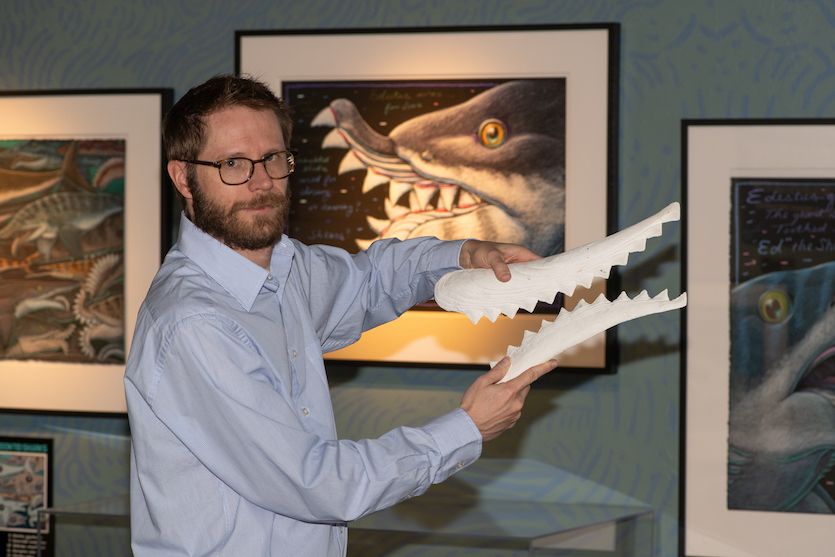Scientists Model How Prehistoric Shark Cut Through Prey With ‘Scissor Jaws’
The 330-million-year-old species Edestus had one of the most unique bites in natural history
/https://tf-cmsv2-smithsonianmag-media.s3.amazonaws.com/filer/37/98/3798b540-d278-4f00-b54b-a5b1b4fd44ae/47586208_2133983463290118_3841363443124017453_n.jpg)
Modern sharks have impressive bites, with aquatic powerhouses such as the great white chomping into prey with rows of serrated teeth arranged in a characteristic half-moon shape. But hundreds of millions of years ago, before the dawn of the dinosaurs, there lived a shark with a bite unlike any other: Edestus, the scissor shark.
Paleontologists have known about Edestus for over 150 years. Fossils of the fish were found in the roughly 330-million-year-old shale of the United States and England, most of them with preserved teeth and parts of the jaw. Since Edestus’ discovery in the 19th century, its jaws have stymied experts looking to understand the feeding habits of this unusual fish. Edestus' two rows of teeth aren’t arranged in a half circle, as in most modern sharks, but rather look like a pair of toothy pinking shears. Nothing like Edestus exists today, but a new analysis of a delicate fossil has solved the mystery of how this ancient marine predator consumed its prey.
The key fossil is known to experts as FMNH PF2204, although Idaho State University paleontologist Leif Tapanila calls it “Ed Head.” On the surface, it doesn’t look like much. Collected by the late paleontologist Rainer Zangerl in the 1960s, “the skull is preserved in what looks like a floor tile of black shale with a hand-sized lump inside,” Tapanila says. But an X-ray of the specimen that Zangerl published in 2004, as well as work on another mystery fish called Helicoprion, inspired Tapanila and his colleagues to think about solving the longstanding mystery of Edestus’ bite.

Up until the new analysis, published in The Anatomical Record, no one could agree on precisely how this fish used its distinctive, saw-like teeth. Each triangular tooth was set in a curved piece of jaw—called a whorl—that jutted from the fish’s mouth. “Dozens of Edestus teeth and full whorls are well preserved and described, but without any context of the full jaws or cranium, previous ideas about the appearance and function are all over the map,” Tapanila says. A specimen at the Smithsonian’s National Museum of Natural History inspired the idea that the jaws of this fish “curved banana-like outside the lips of the animal.” Another recent idea suggested Edestus used its teeth to “slash up-and-down at prey, presumably ripping them apart with mosh-pit fervor,” Tapanila says.
With numerous theories floating around, “Ed Head” was able to shed some light on the mastication of Edestus. The fossil includes the teeth, jaws and skull, which Tapanila and his colleagues modeled with a CT scan to create a three-dimensional representation of the animal’s head. “We were amazed by the skull anatomy because it appears to have two joints in the jaw mechanism,” Tapanila says. During a bite, “the upper and lower blades of teeth snapped toward each other, and the bottom blade glided backward to the throat, slicing its prey in half.”
The bite-and-slice technique of Edestus has never been seen before. “So far as I know, this is a unique type of feeding,” says Humboldt State University paleontologist Allison Bronson. There were other whorl-toothed sharks—like the buzzsaw jaw Helicoprion that Tapanila and colleagues previously studied—but so far, Edestus appears to be unique in having a bite-and-slice mechanism.
“I’m always excited by Dr. Tapanila and colleagues’ use of innovate modeling techniques to address these longstanding mysteries of paleoichthyology, [the study of fossil fish]” Bronson says.
Imagining Edestus in action could certainly inspire some b-movie depictions of a frightening predator in the deep. “The jaw of Edestus seems to be primarily developed to quickly and fatally amputate its prey, snapping them in half, and presumably picking up the falling pieces after the victim was subdued,” Tapanila says. The fact that “decapitated and de-finned fish chunks” were found in the same deposits as Edestus seems to support the idea.
Why Edestus and related fish like Helicoprion evolved their unprecedented bites is the next mystery for paleontologists to sink their teeth into. While cautioning that the idea is speculative, Tapanila suggests that the proliferation of meaty prey—such as ancient relatives of squid and other fish—might have had something to do with the appearance of slicing sharks like Edestus. For now, though, one thing is for sure: Despite being extinct for about 330 million years, Edestus has never looked sharper.
/https://tf-cmsv2-smithsonianmag-media.s3.amazonaws.com/accounts/headshot/RileyBlack.png)
/https://tf-cmsv2-smithsonianmag-media.s3.amazonaws.com/accounts/headshot/RileyBlack.png)